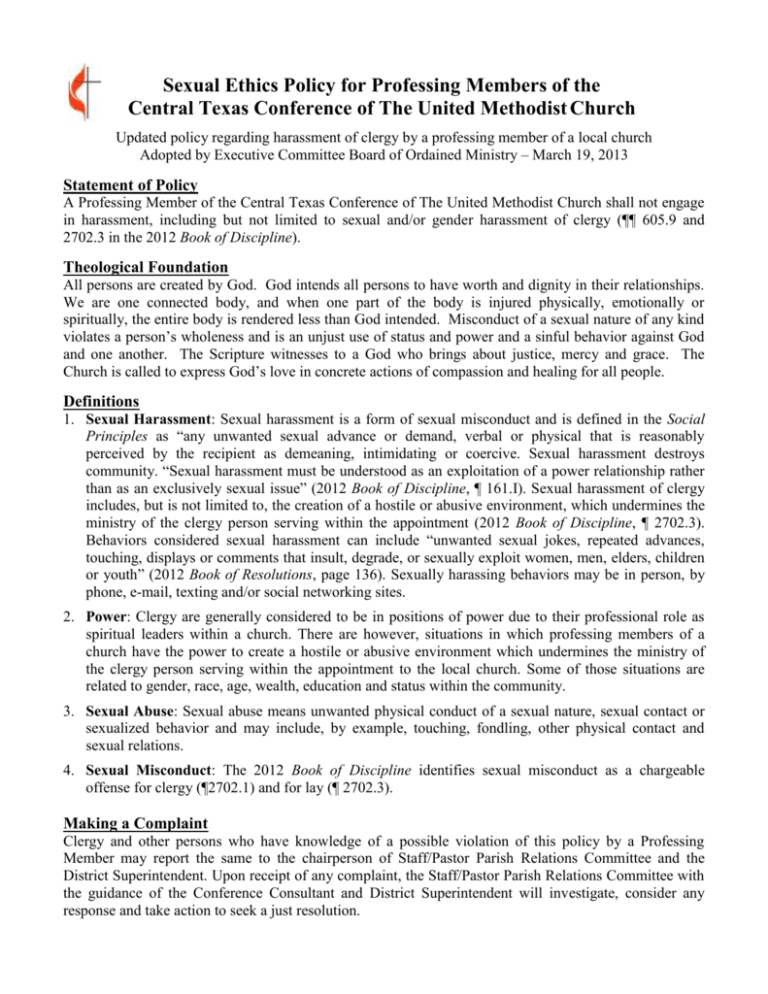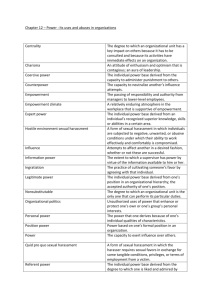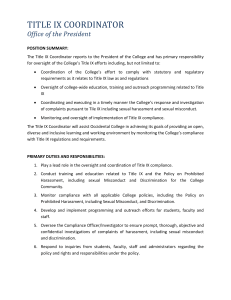
Sexual Ethics Policy for Professing Members of the
Central Texas Conference of The United Methodist Church
Updated policy regarding harassment of clergy by a professing member of a local church
Adopted by Executive Committee Board of Ordained Ministry – March 19, 2013
Statement of Policy
A Professing Member of the Central Texas Conference of The United Methodist Church shall not engage
in harassment, including but not limited to sexual and/or gender harassment of clergy (¶¶ 605.9 and
2702.3 in the 2012 Book of Discipline).
Theological Foundation
All persons are created by God. God intends all persons to have worth and dignity in their relationships.
We are one connected body, and when one part of the body is injured physically, emotionally or
spiritually, the entire body is rendered less than God intended. Misconduct of a sexual nature of any kind
violates a person’s wholeness and is an unjust use of status and power and a sinful behavior against God
and one another. The Scripture witnesses to a God who brings about justice, mercy and grace. The
Church is called to express God’s love in concrete actions of compassion and healing for all people.
Definitions
1. Sexual Harassment: Sexual harassment is a form of sexual misconduct and is defined in the Social
Principles as “any unwanted sexual advance or demand, verbal or physical that is reasonably
perceived by the recipient as demeaning, intimidating or coercive. Sexual harassment destroys
community. “Sexual harassment must be understood as an exploitation of a power relationship rather
than as an exclusively sexual issue” (2012 Book of Discipline, ¶ 161.I). Sexual harassment of clergy
includes, but is not limited to, the creation of a hostile or abusive environment, which undermines the
ministry of the clergy person serving within the appointment (2012 Book of Discipline, ¶ 2702.3).
Behaviors considered sexual harassment can include “unwanted sexual jokes, repeated advances,
touching, displays or comments that insult, degrade, or sexually exploit women, men, elders, children
or youth” (2012 Book of Resolutions, page 136). Sexually harassing behaviors may be in person, by
phone, e-mail, texting and/or social networking sites.
2. Power: Clergy are generally considered to be in positions of power due to their professional role as
spiritual leaders within a church. There are however, situations in which professing members of a
church have the power to create a hostile or abusive environment which undermines the ministry of
the clergy person serving within the appointment to the local church. Some of those situations are
related to gender, race, age, wealth, education and status within the community.
3. Sexual Abuse: Sexual abuse means unwanted physical conduct of a sexual nature, sexual contact or
sexualized behavior and may include, by example, touching, fondling, other physical contact and
sexual relations.
4. Sexual Misconduct: The 2012 Book of Discipline identifies sexual misconduct as a chargeable
offense for clergy (¶2702.1) and for lay (¶ 2702.3).
Making a Complaint
Clergy and other persons who have knowledge of a possible violation of this policy by a Professing
Member may report the same to the chairperson of Staff/Pastor Parish Relations Committee and the
District Superintendent. Upon receipt of any complaint, the Staff/Pastor Parish Relations Committee with
the guidance of the Conference Consultant and District Superintendent will investigate, consider any
response and take action to seek a just resolution.
Reporting, Investigating and Resolving Violations
of the CTC Sexual Ethics Policy for Professing Members
The clergy person who feels harassed by a lay person is encouraged to use the following procedures. If
the offending behavior and complaint is sexual abuse or sexual misconduct then the immediate procedure
is a formal complaint as outlined in the 2012 Book of Discipline ¶ 2703.3. Identifying sexual or gender
harassment depends on a determination of what a reasonable person would perceive as unacceptable. It is
important to resolve complaints confidentially and, if possible, informally.
Initial Resolution Process
1. Clergy are responsible for establishing and maintaining clear boundaries of professional conduct.
2. Therefore, a clergy person should respond immediately and clearly to the harasser that such behavior
is unwelcome and uncomfortable
3. If the behavior continues:
a. Avoid being alone with the harasser.
b. Keep accurate records of the harassing behavior.
c. May contact the Chair of the Staff Parish Relations Committee (if the Chair of SPRC is the
harasser then contact the District Superintendent directly).
d. Notify the District Superintendent.
Informal Resolution Process
1. In all cases, the pastor or District Superintendent should take pastoral steps to resolve any
complaints.
a. The purpose is to determine if the complaint is valid or a miscommunication and a
misunderstanding exist.
b. Ask the accused to make an appropriate written statement to the clergy person. The written
response may include explanation of the behavior resulting in a misperception of intent, an
apology and a promise not to repeat the behavior.
c. If the clergy person finds the response satisfactory then the complaint will be considered as
resolved.
d. If the response of the accused is not satisfactory or the accused refuses to respond, then the
complaint will move to the formal process.
Formal Resolution Process
1. If the District Superintendent determines that the process outlined above has been followed and the
complaint is not resolved, then the district superintendent and district lay leader may appoint a
committee on investigation according to ¶ 2703.3 in the 2012 Book of Discipline.
2. The final decision of the committee will be communicated in writing to the clergy person and the
accused. Should this not be resolved it then moves to ¶2704.4 in the 2012 Book of Discipline.









